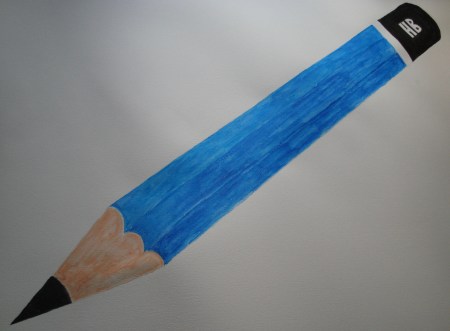
More Pencil Industry news
Courtesy of the Czech Business Weekly, an interesting read on pencils from the home of Koh-I-Noor Hardmuth.
Stationery Magazine
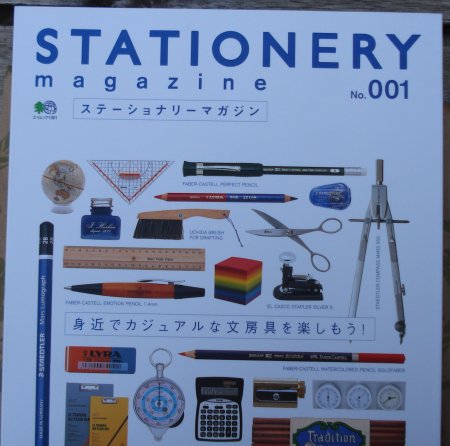
I can’t read much of it, yet it seems to speak very well to many interests of mine.
Red and blue pencils, leadholders, quirky office accessories – they’re all here, and featured prominently.
The magazine is in Japanese, with about 150 glossy pages crammed full of photos of woodcase pencils, mechanical pencils, leadholders, erasers, sharpeners, staplers, hole punches, rulers, and much more.
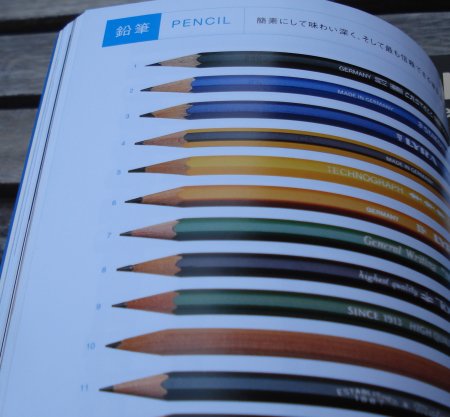
Yes, they have a page on Vernier calipers:
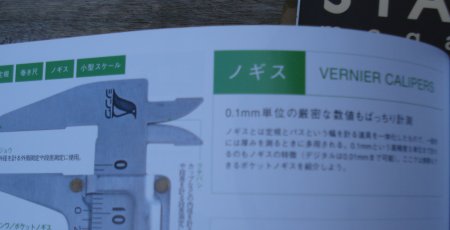
Sharpeners also.
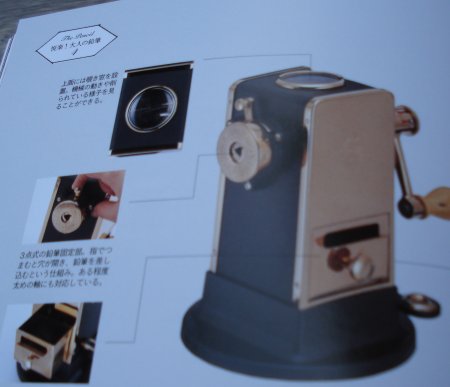
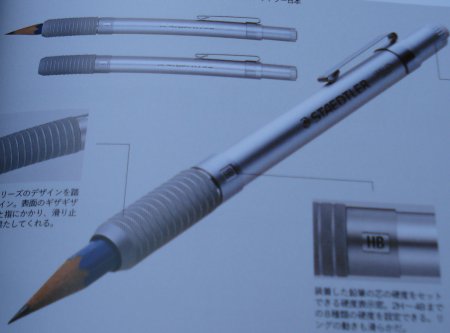
Pentel Multi8
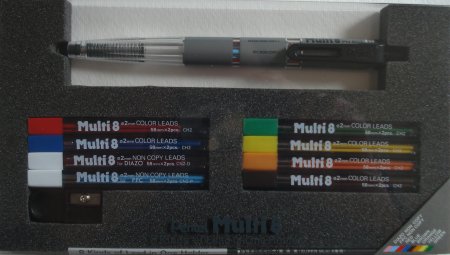
Mechanical pencils with multiple usable leads can be seen at online auction sites or at the uncomfortable chair, though I have never previously seen one in person.
I also remember school days, when those Bic four colour ballpoints became popular.
My opinion was that they were a gimmick – a solution to no particular problem.
So when I heard of a pencil that used eight leads, I was somewhat surprised. And when I learned that those leads were the 2mm diameter used by leadholders, the tide seemed to turn, and I decided to get one.
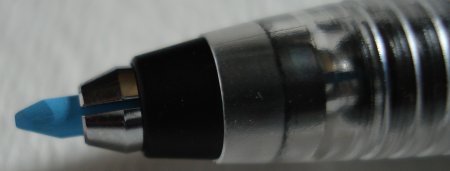
I think I wanted to see just how far this idea could be taken. It is probably the oddest writing implement yet seen at pencil talk.
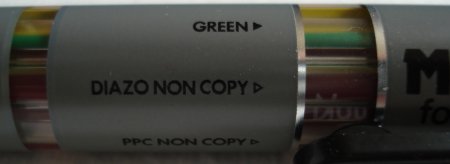
The pencil exterior looks kind of cheap, like something one would find at those suburban big box office supply stores.
The mechanism is quite interesting – each lead has a small metal 4mm sleeve at the end, and eight anchors hold the leads by these sleeves. Rotating the clip to a colour relases that lead, which can then be held by the clutch mechanism.

Eight leads are supplied. They are (clockwise, starting at the upper left): red, blue, brown, orange, yellow, green, Diazo non copy, and PPC non copy.
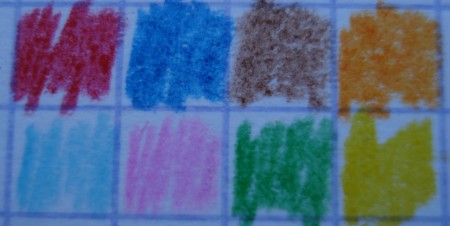
The non-copy varieties are intriguing offerings. It’s strange that a regular graphite core didn’t make the cut.
I found the pencil very easy to use. The variety of colours makes it very useful for organizational tasks that depend on colour coding. Alternately, the Multi8 could be seen as a compact colour pencil set for light use.
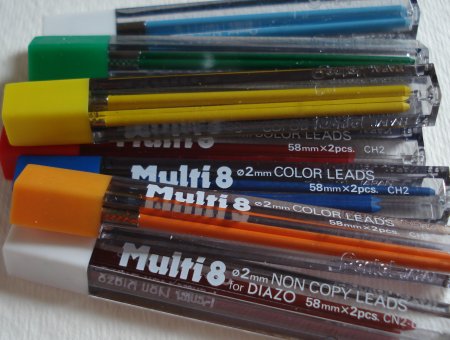
The pencil came with refills in each colour, an instruction leaflet (English/Japanese), and a small lead sharpener.
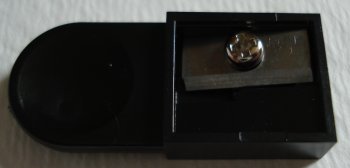
It is a very nice, almost unique item. I gather Pentel also manufacture a few related versions, some of which have ballpoint offerings. This particular model is the “Multi8 PH802 for checking use.” My only problems were some lead breakage, and a rattling sound that the pencil makes.
Timberlines Pencil Collection – Part 1
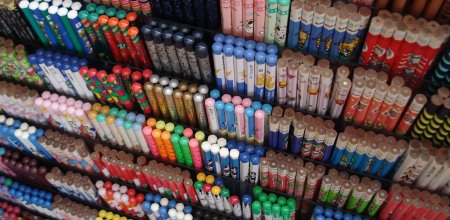
This is the first post in a series about the Timberlines Pencil Collection.
The collection name is improvised – the pencils are a large set of Japanese woodcase pencils that were featured on the Timberlines blog in 2006, so I thought that calling it the Timberlines Pencil Collection was a fitting tribute.
The set is housed in an acrylic display case. The case has ten rows, each row holding twelve ‘slots’. A slot can hold a dozen pencils, so the collection has 120 pencils varieties – and would have 1440 pencils if full. A few pencils are randomly missing from the collection, so there are about 1420 pencils at present.
The pencils are from a range of manufacturers. They are both sharpened and unsharpened, with and without erasers, capped and uncapped, round and hexagonal, and with many other twists that we’ll discover.
I plan on presenting occasional posts on groups of pencils, working through the collection row by row. The plan is to show three to five pencils at a time, each pencil with a small photo or two, and the individual pencil features quickly summarized. I’ll try and note any distinguishing features of the pencils.
Lets get started.
Pencil No. 1 is a novelty pencil, round with a brass-coloured ferrule. The eraser has six colours, in pie shaped wedges. The surface appears to be matte paper. It is marked, “HB 50 A-641 Be Goody Made in Japan.” The pattern shows line drawings of animals.
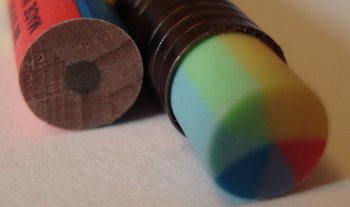

Pencil No. 2 is similar to No. 1. However the paper is shiny, the ferrule silver coloured, and the eraser is a light purple with an imbedded whale image. It is marked, “HB 50 A-683 Be Goody Made in Japan.” The pattern shows whales, dolphins, and sea creatures.
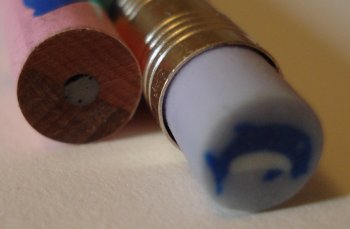
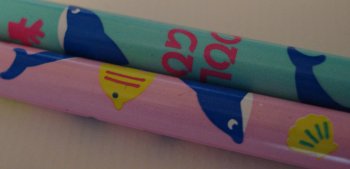
Pencil No. 3 is hexagonal, with no cap, ferrule, or eraser. It has a pattern of fish, plankton, etc., and is marked “TR003 Made in Japan Top Runner”.
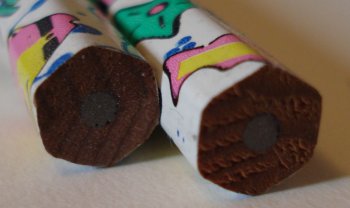
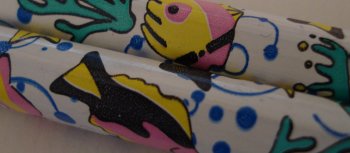
Pencil No. 4 is more familiar – it is a Mitsubishi Uni in 2B, Mitsubishi Pencil Co.’s second top pencil. It is marked “Established 1887 [logo] Mitsu-Bishi Uni 2B” and “Pressure-Proofed Hi-Density Lead 2B”. The pencil is capped.
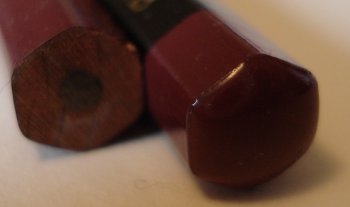
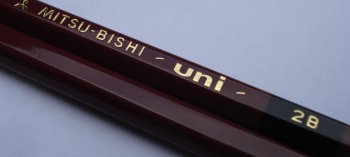
IBM Electrographic pencil
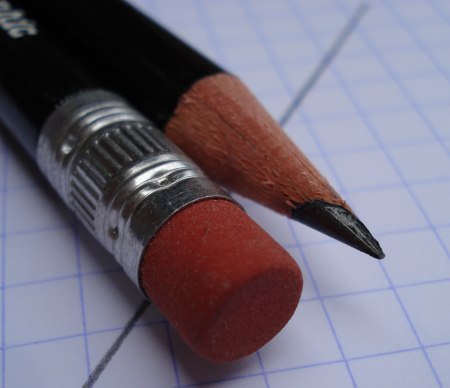
Today we have another special treat for pencil talk readers.
The IBM Electrographic is among the most sought after and collectable modern pencils, along with the Blackwing 602 and Blackfeet Indian. It might be the rarest of the three, though one never knows what warehouse stockpiles of pencils may exist.
The pencil was just a small component of a much larger enterprise – IBM’s development of Mark Sense technology. The central idea is the automated (machine) reading of human made marks in a variety of settings, though standardized tests and utility bills seem to have been the most well known areas.
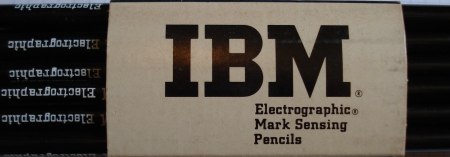
As well as making a black mark, graphite makes a luminescent and electrically conductive mark. That is the basis of the technology. Some readers may have more to contribute in this area, which I would welcome, but I’ll focus here on the pencil. Some links below are suggestions for further reading on the larger technology.
The pencil is round, and finished in black. It has a silver coloured ferrule, and dark pink eraser. The eraser is predictably not useful after several years.

The pencil is embossed with an appropriate font in white, “IBM Electrographic”.
The pencil sharpens easily, and reveals a nice reddish cedar.
The pencil writes exceptionally well. Not just in the way some pencils are a gradient or two smoother or softer than others – there is something unusual in the lead formula which results in an incredibly smooth line. The line also seems much more luminescent or shiny than a regular pencil mark.
The lead does crumble a bit while writing. In outdoor sunlight, the lines seem more shiny than black.

After trying out the pencil, I have no doubt that those proclaiming that there is something special about the IBM Electrograph are correct. Though the pencils may have been created for standardized tests, there is no wonder about why a larger audience of writers quickly adopted them.
The IBM Electrograph is a standout pencil.
Further reading:
IBM 1231 Optical Mark Page Reader (ibm1130.com)
Mark sense (Wikipedia)
IBM 805 Test Scoring Machine (IBM Archives)
Optical mark recognition (Wikipedia)
